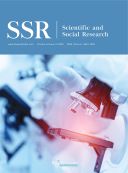Abstract
Recent years have seen a rise in the development of technological innovations and their implementation in various industries. Specifically, law enforcement agencies across the United States have partnered with technology companies to deploy facial recognition algorithms in the identification and prosecution of criminal suspects. Yet there is concern that law enforcement’s use of facial recognition algorithms based on biased mugshot data pools can lead to criminalizing innocent civilians. Prominent theories including intersection theory, instrumentalization theory, and Alvarado’s theory were analyzed to review arguments that justify concern. We find that intersection theory is supported by empirical evidence that women of color are put at the greatest disadvantage from technological bias; instrumentalization theory is supported by examples of both positive and negative implementations of facial recognition technology, and Alvarado’s theory further suggests the possible reinforcement of existing biases by these poor applications of technology.
References
Jiao F, Gao W, Chen X, et al., 2002, Proceedings of the 5th Asian Conference on Computer Vision, A Face Recognition Method Based on Local Feature Analysis, January 23-25, 2002, Melbourne.
IBM Cloud Education, 2020, Neural Networks, IBM Cloud Learn Hub, viewed July 26, 2022, https://www.ibm.com/cloud/learn/neural-networks
Hardesty L, 2017, Explained: Neural Networks, MIT News, April 14, 2017, viewed July 26, 2022, https://news.mit.edu/2017/explained-neural-networks-deep-learning-0414
Karamizadeh S, Abdullah MS, 2013, An Overview of Holistic Face Recognition. International Journal of Research in Computer and Communication Technology, 2(9): 738–741. https://www.researchgate.net/publication/262725509_An_Overview_of_Holistic_Face_Recognition
Thorat SB, Nayak SK, Dandale JP, 2010, Facial Recognition Technology: An Analysis with Scope in India. International Journal of Computer Science and Information Security, 8(1): 325–330. arxiv.org/pdf/1005.4263.pdf
Müge Çar?kç?, Figen Özen, 2012, A Face Recognition System Based on Eigenfaces Method. Procedia Technology, 1: 118–123. https://doi.org/10.1016/j.protcy.2012.02.023
Dargham JA, Chekima A, Hamdan M, 2012, Hybrid Component-Based Face Recognition System, in Distributed Computing and Artificial Intelligence, Springer, Berlin, 573–580
Shashkina V, 2022, Business Guide to Facial Recognition: Benefits, Applications, and Issues to Consider, Itrex, viewed August 29, 2022, https://itrexgroup.com/blog/facial-recognition-benefits-applications-challenges/#
Parker J, 2020, Facial Recognition Success Stories Showcase Positive Use Cases of the Technology, Security Industry Association, viewed Aug 29, 2022, https://www.securityindustry.org/2020/07/16/facial-recognition-success-stories-showcase-positive-use-cases-of-the-technology/
Marr B, 2019, Facial Recognition Technology: Here Are the Important Pros and Cons, Forbes, viewed Aug 29, 2022, https://www.forbes.com/sites/bernardmarr/2019/08/19/facial-recognition-technology-here-are-the-important-pros-and-cons/?sh=10e9fcb214d1
McCarthy C, 2019, How NYPD’s Facial Recognition Software ID’ed Subway Rice Cooker Kook, New York Post, August 25, 2019, viewed, 29 Aug. 2022, https://nypost.com/2019/08/25/how-nypds-facial-recognition-software-ided-subway-rice-cooker-kook/
Wendorf M, 2019, Facial Recognition Technology Is Being Used to Find Missing Children, Interesting Engineering, viewed August 29, 2022, https://interestingengineering.com/innovation/facial-recognition-technology-is-being-used-to-find-missing-children
Najibi A, 2020, Racial Discrimination in Face Recognition Technology, Security Industry Association, viewed July 26, 2022, https://sitn.hms.harvard.edu/flash/2020/racial-discrimination-in-face-recognition-technology/
Lee NT, Chin C, 2022, Police Surveillance and Facial Recognition: Why Data Privacy Is Imperative for Communities of Color, Brookings Institution, viewed 26 July, 2022, https://www.brookings.edu/research/police-surveillance-and-facial-recognition-why-data-privacy-is-an-imperative-for-communities-of-color/#:~:text=(A)%20Facial%20recognition&text=In%202016%2C%20Georgetown%20Law%20researchers,FRT%20to%20law%20enforcement%20agencies
Gershgorn D, 2020, Clearview AI: We Are ‘Working to Acquire All U.S. Mugshots’ From Past 15 Years. OneZero, viewed August 29, 2022, https://onezero.medium.com/clearview-ai-we-are-working-to-acquire-all-u-s-mugshots-from-past-15-years-645d92319f33
Buolamwini J, Gebru T, 2018, Gender Shades: Intersectional Accuracy Disparities in Commercial Gender Classification, Proceedings of Conference on Fairness, Accountability and Transparency.
Balko R, 2020, There’s Overwhelming Evidence That the Criminal Justice System Is Racist: Here’s the Proof, Washington Post, June 10, 2020, viewed August 29, 2022, https://www.washingtonpost.com/graphics/2020/opinions/systemic-racism-police-evidence-criminal-justice-system/
National Institute of Standards and Technology, 2019, NIST Study Evaluates Effects of Race, Age, Sex on Face Recognition Software, viewed August 29, 2022, https://www.nist.gov/news-events/news/2019/12/nist-study-evaluates-effects-race-age-sex-face-recognition-software
Harwell D, 2019, Federal Study Confirms Racial Bias of Many Facial-Recognition Systems, Casts Doubt on Their Expanding Use, Washington Post, December 19, 2019, viewed Aug 29, 2022, https://www.washingtonpost.com/technology/2019/12/19/federal-study-confirms-racial-bias-many-facial-recognition-systems-casts-doubt-their-expanding-use/
Ozer N, Ruane K, Cagle M, 2021, Grassroots Activists Are Leading the Fight to Stop Face Recognition. It’s Time for Congress to Step Up, Too, ACLU, June 17, 2021, viewed 26 July 2022, https://www.aclu.org/news/privacy-technology/grassroots-activists-are-leading-the-fight-to-stop-face-recognition-its-time-for-congress-to-step-up-too
Federal Bureau of Prisons, 2020, Inmate Statistics, viewed August 29, 2022, https://www.bop.gov/about/statistics/statistics_inmate_gender.jsp
Beck A, 2021, U.S. Department of Justice, Race and Ethnicity of Violent Crime Offenders and Arrestees, 2018, viewed September 5, 2022, https://bjs.ojp.gov/content/pub/pdf/revcoa18.pdf
Katsanis SH, Claes P, Doerr M, et al., 2021, A Survey of U.S. Public Perspectives on Facial Recognition Technology and Facial Imaging Data Practices in Health and Research Contexts. PLOS ONE, 16(10): e0257923. https://doi.org/10.1371/journal.pone.0257923
Useful Theories and Their Application to Media Texts, n.d., viewed July 26, 2022, https://resource.download.wjec.co.uk/vtc/2015-16/15-16_int_04/website/eng/9%20-%20Useful%20Theories%20and%20their%20application%20to%20media%20texts/index.html
Theories of Race and Ethnicity, n.d., viewed July 26, 2022 https://opened.cuny.edu/courseware/lesson/161/student/
Feenberg A, Critical Theory of Technology, n.d., viewed July 26, 2022, https://www.sfu.ca/~andrewf/books/Critical_Theory_Technology.pdf
Sliwa J, 2022, People See Black Men as Larger, More Threatening than Same-Sized White Men. American Psychological Association, 13 March 2017, viewed July 26, 2022, https://www.apa.org/news/press/releases/2017/03/black-men-threatening
Rauenzahn B, Chung J, Kaufman A, 2021, Facing Bias in Facial Recognition Technology. The Regulatory Review, March 20, 2021, viewed July 26, 2022, https://www.theregreview.org/2021/03/20/saturday-seminar-facing-bias-in-facial-recognition-technology/
Goldberg RD, 2021, You Can See My Face, Why Can’t I? Facial Recognition and Brady. Columbia Human Rights Law Review, 2021, viewed July 26, 2022, https://hrlr.law.columbia.edu/hrlr-online/you-can-see-my-face-why-cant-i-facial-recognition-and-brady/
Ng A, 2020, Police Are Using Facial Recognition for Minor Crimes Because They Can, CNET, October 4, 2020, viewed 26 July 2022, https://www.cnet.com/news/privacy/police-are-using-facial-recognition-for-minor-crimes-because-they-can/
Garvie C, 2020, The Untold Number of People Implicated in Crimes They Didn’t Commit Because of Face Recognition, ACLU, June 20, 2020, viewed 26 July 2022, https://www.aclu.org/news/privacy-technology/the-untold-number-of-people-implicated-in-crimes-they-didnt-commit-because-of-face-recognition#:~:text=We%20have%20no%20idea%20how,every%20month%E2%80%94in%20Florida%20alone
Trivedi S, Wessler NF, 2019, Florida Is Using Facial Recognition to Convict People Without Giving Them a Chance to Challenge the Tech, ACLU, March 12, 2019, viewed August 29, 2022, https://www.aclu.org/blog/privacy-technology/surveillance-technologies/florida-using-facial-recognition-convict-people.
Aaron Mak, 2019, Facing Facts: A Case in Florida Demonstrates the Problems with Using Facial Recognition to Identify Suspects in Low-Stakes Crimes, Slate, Jan 25, 2019, viewed August 29, 2022, https://slate.com/technology/2019/01/facial-recognition-arrest-transparency-willie-allen-lynch.html.
FT Reporters, 2021, In Charts: Facial Recognition Technology? And How Much Do We Trust It?, Financial Times, May 16, 2021, viewed August 29, 2022, https://www.ft.com/content/f6a9548a-a235-414e-b5e5-3e262e386722
Kisi O, Alizamir M, Gorgij AD, 2020, Dissolved Oxygen Prediction Using a New Ensemble Method. Environmental Science and Pollution Research, 27: 9589–9603. https://doi.org/10.1007/s11356-019-07574-w
Kodinariya TM, 2014, Hybrid Approach to Face Recognition System using Principle Component and Independent component with Score-based Fusion Process. Computer Vision and Pattern Recognition, 2014: 1401.0395. https://doi.org/10.48550/arXiv.1401.0395
